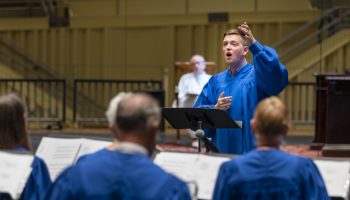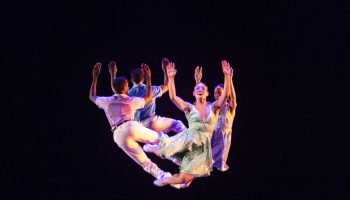Concerto for Violin and Orchestra in D Major, op. 35
Peter Ilyich Tchaikovsky
Peter Ilyich Tchaikovsky was born on May 7, 1840, in Votkinsk, Russia, and died on Nov. 6, 1893, in Saint Petersburg. He remains one of the most popular composers of all time, beloved especially for his symphonies, ballets and concertos. His Violin Concerto was composed in 1878 and received its first performance in Vienna on Dec. 4, 1881, with Russian virtuoso Adolph Brodsky as soloist and Hans Richter conducting the Vienna Philharmonic. Its first reviews were devastating, yet over the course of time it has become one of the most popular works in the concerto repertory.
The initial inspiration for Tchaikovsky’s Violin Concerto was a performance of Édouard Lalo’s “Symphonie Espagnole” for violin and orchestra given by the great virtuoso, Yosif Kotek, sometime in late 1877 or early 1878. Tchaikovsky worked quickly on the new concerto, starting on March 17, 1878, taking a mere 11 days to sketch it out. The complete score was finished by April 11. How many works of such magnitude can claim such a short gestation period? Kotek, who served as technical adviser to Tchaikovsky (who was not a violinist), gave a private performance of the piece in Clarens, Switzerland, on April 3.
Despite Kotek’s important role in the genesis of the piece, Tchaikovsky chose to dedicate it to Leopold Auer, professor of violin at the Conservatory in Saint Petersburg. Auer, however, not only rejected the dedication, but went on to declare the concerto unplayable, advising all other violinists to shun it. Adolph Brodsky ignored Auer’s judgment and gave Tchaikovsky’s Violin Concerto its world premiere with orchestra on Dec. 4, 1881, in Vienna. A scathing review by Eduard Hanslick in the Neue Freie Presse may be have been attributable in part to the fact that Brodsky was allowed only one rehearsal with orchestra. The orchestra parts, as it also happened, were filled with so many mistakes that the conductor, Hans Richter, asked the orchestra to play pianissimo throughout the entire work. Hanslick may also have been comparing Tchaikovsky’s Violin Concerto with that of Brahms (a work that was composed at the same time as Tchaikovsky’s, and which had its premiere in Leipzig in 1879). A closer reading of Hanslick’s review, however, reveals a decidedly anti-Russian bias:
“The Russian composer Tchaikovsky is surely not an ordinary talent, but rather an inflated one, with a genius-obsession without discrimination or taste. Such is also his latest, long and pretentious Violin Concerto. For a while it moves soberly, musically, and not without spirit. But soon vulgarity gains the upper hand, and asserts itself to the end of the first movement. The violin is no longer played; it is pulled, torn, drubbed. The Adagio is again on its best behavior, to pacify and to win us. But it soon breaks off to make way for a finale that transfers us to a brutal and wretched jollity of a Russian holiday. We see plainly the savage vulgar faces, we hear curses, we smell vodka. Friedrich Vischer once observed, speaking of obscene pictures, that they stink to the eye. Tchaikovsky’s Violin Concerto gives us for the first time the hideous notion that there can be music that stinks to the ear.” — Translation by Nicolas Slonimsky, Lexicon of Musical Invective (Seattle, 1953)
This virulent anti-Russianism may also be found in other Viennese reviews, but the fact that the composer’s Russian confidante and patron, Madame von Meck, also was displeased with the Violin Concerto indicates that its national character was not its only problem. Tchaikovsky was, of course, deeply wounded by such hostility. Time, however, proved to be the Violin Concerto’s best ally. In 1893, Auer himself finally performed the “unplayable” concerto (with modest revisions), and went on to teach it to all of his most gifted pupils, among whom we may count some of the great virtuosi of the 20th century — Efrem Zimbalist, Mischa Elman and Jascha Heifetz. But Auer’s change of heart came too late in one sense. The composer dedicated the work, appropriately, to the courageous Brodsky.
Tchaikovsky’s Violin Concerto shares one important feature with another Romantic concerto — the one for violin by Felix Mendelssohn. I refer here to a cadenza in the first movement that is written out by the composer and placed at the beginning of the recapitulation, rather than at the end. Tchaikovsky’s Violin Concerto, virtuoso showpiece that it is, is filled with many of the lovely melodies one associates with the composer’s most popular ballet scores. The melody of the Canzonetta (a substitution for the original slow movement, which was later issued independently as his “Méditation,” op. 42) surely ranks among Tchaikovsky’s most felicitous ideas. The solo part in the beginning of this movement is played with a mute, which not only softens the instrument’s dynamic range, but alters its tone color. The fiery Allegro vivacissimo finale, so despised by Hanslick, nowadays is admired and beloved for its indomitable sense of fun, as well as for the sheer excitement it is able to generate.
Symphony No. 1 in C minor, op. 68
Johannes Brahms
Johannes Brahms was born on May 7, 1833, in Hamburg and died in Vienna on April 3, 1897. One of the dominant composers of the late 19th century, Brahms greatly enriched the repertory for piano, organ, chamber music, chorus, art song and orchestra. His Symphony No. 1 was composed between 1862 and 1876 and received its first performance in Karlsruhe on Nov. 4, 1876, under the direction of Felix Otto Dessoff. The work is scored for two flutes, two oboes, two clarinets, two bassoons, contrabassoon, four horns, two trumpets, three trombones, timpani and strings.
The four symphonies of Johannes Brahms stand as monuments to Beethoven. No composer of symphonies after Beethoven could escape the shadow of his nine masterpieces. Mendelssohn’s solution to the problem was to circumvent them by returning to a Mozartian ideal. Robert Schumann struggled consciously to measure up by attempting to synthesize a historical perspective with novel innovations. Berlioz and Liszt followed the path of the “program” symphony, attaching extra-musical ideas to their purely musical inventions, while Richard Wagner self-servingly decreed that after the choral Ninth Symphony of Beethoven, purely instrumental symphonies were an impossibility. Musicians such as Joachim Raff, Niels Gade and Louis Spohr also penned symphonies, but these are regarded nowadays as historical curiosities. Some composers, such as Chopin, became specialists who avoided the issue entirely by writing no symphonies at all.
Brahms was so acutely aware of the problem that for a long time it seemed that he, too, would avoid composing symphonies. His sketches for the Piano Concerto No. 1 indicate that the first movement of that mighty work was at one time intended to belong to a symphony. His subsequent works for orchestra — “A German Requiem,” the two “Serenades” (op. 11 and 16) and the “Variations on a Theme by Haydn” (St. Anthony chorale) and other choral works — all veered away from the title symphony. In the early 1860s, Brahms began to sketch ideas for what would emerge as his Symphony No. 1, but he did not finish work on it until 1876. An early draft of the first movement omitted the powerful Un poco sostenuto introduction, one of the many great inspirations of the work. But now in his 40s, Brahms felt confident enough to take the plunge.
The wait was worthwhile. Few first attempts at composing a symphony, except perhaps the one by Gustav Mahler, were as imposing as this one. Sure of his craft and purpose, Brahms approached the Beethovenian model head on. The most obvious points of reference for this symphony were Beethoven’s Symphonies Nos. 5 and 9. The latter must be included for the obvious similarity between the melody of Beethoven’s “Ode to Joy” and the principal theme in the finale of Brahms’ symphony. Brahms was roundly criticized by some for cribbing this tune directly from Beethoven’s Ninth Symphony, to which the composer replied in his typically gruff manner: “Any jackass can see that!” More recently, musicologist Mark Evan Bonds has suggested that Brahms’ purely instrumental finale represented an alternative to Beethoven’s choral last movement. As was the case in Beethoven’s Symphonies Nos. 5 and 9, Brahms begins his symphony with a dramatic and tragic first movement, ending in a triumphant finale representing the victory of light over dark.
Brahms’ Symphony No. 1 begins solemnly with a slow introduction that presents not only the main ideas of the first movement, but those of the entire work — two chromatic lines that pull in contrary motion. At the outset, the descending line is heard in the winds, while the strings surge upward. The tension that this creates is intensified by the throbbing pulse of the timpani that tenaciously hangs on to one note, refusing to yield ground. These frictions are exploited in the sonata-form Allegro, but now these opposing lines are given an angular rhythmic profile. The movement concludes with a shortened version of the introduction, with the minor mode yielding, almost in exhaustion, to the parallel C major (a characteristic found at the end of the first movement of Beethoven’s final Piano Sonata, op. 111). The Andante sostenuto that follows offers relief from the first movement’s tension in a serene distant key of E major, well prepared by the first movement’s last moment shift to C major. Its mood derives from the hymnal quality of its opening theme. A particular beautiful timbre is created by the oboe, horn and solo violin at the end of the movement. Once again, the composer prepares the ear for a shift to a foreign tonality (A-flat major) by having the solo violin cling to the note G sharp (G sharp = A flat) at the end of the Andante sostenuto. The third movement, Un poco allegretto, provides further contrast of mood and tonality (A-flat major, with a central section in B major). Brahms wisely avoids the demonic energy of a Beethovenian scherzo at this point, saving that energy for the finale to come. The final movement begins with a moody Adagio, reminiscent of the introduction to the first movement. Listeners should pay close attention to its first few notes, as they are a minor-mode prefiguration of the wonderful and familiar tune that will dominate the finale. As the introduction builds to a climax, a Piu andante ensues with a new — and brighter — theme in the horns, presented over rustling string accompaniment. The trombones then intone a noble and solemn “chorale.” Now follows the famous Allegro non troppo ma con brio that comprises the main body of the finale, as the listener luxuriates in the affirmative tune that the opening of the introduction had prefigured. The symphony closes with a jubilant coda, crowned by a powerful restatement of the trombone “chorale.”
David B. Levy is professor of music at Wake Forest University in Winston-Salem, North Carolina. He will present a pre-concert lecture on tonight’s program at 6:45 p.m. in the Hurlbut Church sanctuary.




